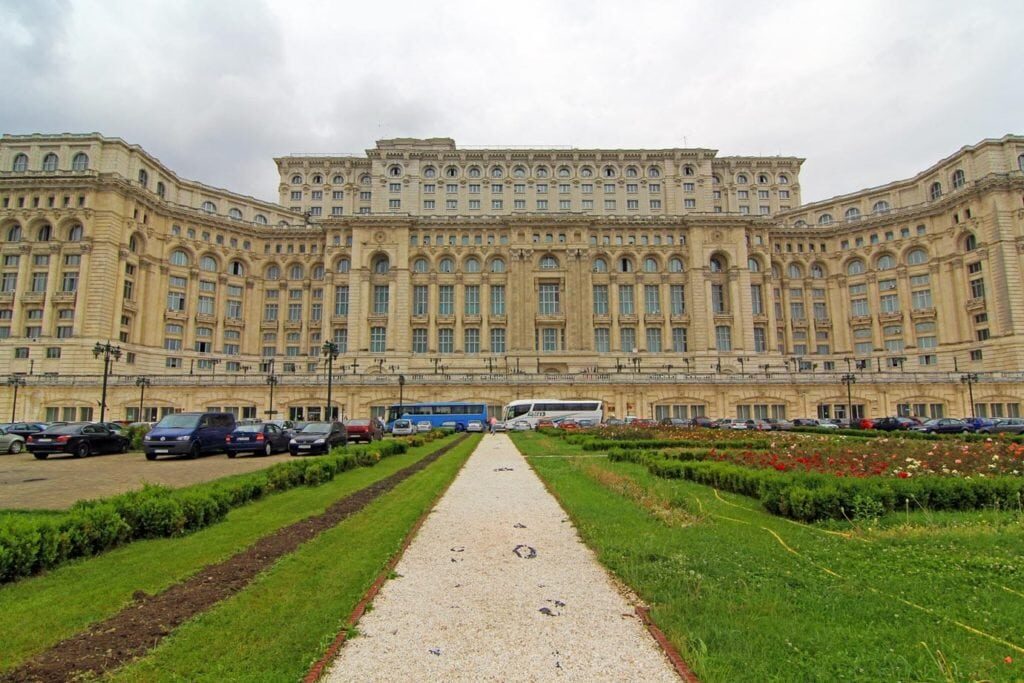The Palace of Parliament in Bucharest, Romania, stands as a monumental symbol of power and authority. Renowned for its impressive scale, intricate architecture, and political importance, it holds a unique place in the country’s history. Known as the second-largest administrative building in the world, the Palace is not only the seat of Romania’s Parliament but also a striking example of the nation’s architectural ambition. It represents a blend of governance, culture, and history, making it a must-see for visitors and a central landmark in Romanian identity.
The Origins of the Palace of Parliament
The construction of the Palace of Parliament began during the communist era under the leadership of Nicolae Ceaușescu. It was part of a grand urban transformation plan aimed at reshaping Bucharest into a model socialist capital. Originally called the People’s House, the building was intended to symbolize the power and prosperity of the regime. Romanian architect Anca Petrescu led the design, working with a team of thousands of architects and engineers. Construction started in 1984 and continued until the fall of the communist government in 1989. Although unfinished at the time of Ceaușescu’s overthrow, the palace remains a powerful reminder of his reign.
A Monumental Architectural Achievement
The Palace of Parliament is a masterpiece of neo-classical architecture with modernist influences. Covering an area of 365,000 square meters, it is a colossal structure with 12 above-ground floors and 8 underground levels. The exterior is adorned with grand columns, elaborate stone carvings, and symmetrical facades that reflect both power and elegance. The entire building was constructed using Romanian materials, including marble, rich woods, and crystal, showcasing the country’s natural resources and craftsmanship. Its monumental design and overwhelming scale leave visitors awestruck.
Inside the Palace: A World of Luxury and Detail
The interior of the Palace of Parliament is a true reflection of luxury and meticulous attention to detail. Every room and hallway is adorned with the finest materials, from marble and gold leaf to hand-carved wood and silk wall coverings. Massive crystal chandeliers hang from high ceilings, illuminating the grand halls with a warm, opulent glow. The building’s most famous spaces include the Hall of Human Rights and the Hall of the Union, each showcasing intricate architectural features and lavish design elements. Walking through the palace is like stepping into a world of grandeur and historical significance.
The Palace as the Seat of Governance
Beyond its architectural marvels, the Palace of Parliament serves an essential role in Romania’s political life. It is the headquarters for both the Chamber of Deputies and the Senate, where key decisions and legislative processes take place. The building’s vast conference halls and offices are used for parliamentary sessions, political debates, and official events. As the heart of Romanian governance, the palace represents the country’s political journey from communism to democracy, reflecting the nation’s evolving identity.
A Cultural Hub for Art and History
In addition to its political functions, the Palace of Parliament has become a cultural hub. It houses the National Museum of Contemporary Art (MNAC), which features a diverse collection of Romanian and international works. The museum adds a modern touch to the historical structure, offering visitors a unique blend of past and present. The palace also hosts various cultural events, exhibitions, and conferences, drawing visitors from around the world. Its transformation into a cultural venue has helped redefine its legacy, making it a place where history and art intersect.
The Challenges and Controversies
The construction of the Palace of Parliament was not without controversy. Thousands of families were displaced, and entire neighborhoods, churches, and historic buildings were demolished to make way for the project. The immense cost of the building put a strain on Romania’s economy during a difficult period, leaving a lasting impact on the nation’s finances. For many Romanians, the palace is a symbol of Ceaușescu’s authoritarian rule and the hardships endured during its construction. Despite these challenges, it has since been embraced as an important part of the country’s heritage.
A Building of Records and Superlatives
The Palace of Parliament holds numerous records that highlight its extraordinary scale and grandeur. It is the heaviest building in the world, with an estimated weight of over 4 million tons. It is also one of the largest administrative buildings globally, with some of the most extensive crystal chandelier collections and enormous carpets. These impressive features attract tourists, architects, and historians from all over the world, eager to witness this architectural marvel firsthand.
Visiting the Palace of Parliament
Today, the Palace Parliament is one of Romania’s most popular tourist attractions. Guided tours allow visitors to explore its grand halls, staircases, and chambers while learning about its complex history. The National Museum of Contemporary Art offers an additional layer of interest, showcasing Romania’s vibrant modern art scene. Security is tight due to the building’s active political role, and visitors must book tours in advance. The experience, however, is unforgettable, offering a glimpse into the nation’s past and present.
Palace Parliament: An Architectural Masterpiece
The Palace of Parliament in Bucharest, Romania, is a stunning symbol of architectural brilliance and human ambition. Recognized as one of the largest and most impressive buildings in the world, this monumental structure blends history, art, and politics. Constructed during Romania’s communist era, it stands today as a powerful reminder of the country’s past while also serving as a vital part of its present. The Palace of Parliament is not just a government building; it is an architectural masterpiece that continues to captivate the world.
A Visionary Project
The construction of the Palace of Parliament was part of Nicolae Ceaușescu’s grand vision to transform Bucharest into a modern socialist capital. The project began in 1984 and was driven by the desire to create a building that would symbolize the power and self-sufficiency of the communist regime. Romanian architect Anca Petrescu, who was only 28 years old at the time, led a team of over 700 architects in designing this colossal structure. The building was designed to dominate the city’s skyline and showcase Romania’s strength and resources.
Monumental Scale and Records
The Palace of Parliament is one of the largest administrative buildings in the world, second only to the Pentagon in terms of size. It covers an astonishing 365,000 square meters and has 12 above-ground floors and 8 underground levels. It is also the heaviest building on Earth, weighing over 4 million tons due to the extensive use of steel, marble, and concrete. Its vast size and complex structure make it a marvel of modern engineering and architecture, attracting tourists and experts from all over the globe.
Neo-Classical Architecture with a Modern Twist
The architecture of the Palace of Parliament is primarily neo-classical, characterized by grand columns, symmetrical facades, and elaborate decorative elements. The design draws inspiration from ancient Greek and Roman architecture but incorporates modernist influences as well. The building’s grandiosity is evident in its massive staircases, high ceilings, and expansive halls. Despite its imposing exterior, the palace also reveals intricate details in every corner, from stone carvings to beautifully crafted balconies, showcasing the incredible craftsmanship involved in its construction.
Opulent Interior Design
The interior of the Palace of Parliament is a dazzling display of luxury and attention to detail. Every room is meticulously designed with the finest materials, including marble, gold leaf, crystal, and hand-carved wood. Romanian materials were exclusively used in the construction, highlighting the country’s rich natural resources and skilled artisans. The palace features over 3,500 tons of crystal, with massive chandeliers hanging in its grand halls. Velvet curtains, silk wall coverings, and intricately woven carpets enhance the sense of opulence and elegance, creating an unforgettable visual experience for visitors.
The Role of Light and Space
One of the most striking features of the Palace of Parliament is the use of light and space. The building’s designers paid close attention to how natural light filters through its grand windows, creating a sense of openness despite its massive size. The vast halls and high ceilings contribute to the feeling of grandeur, while carefully positioned windows allow light to illuminate the marble floors and gold accents. This interplay of light and space adds to the building’s magnificence and makes every corner feel alive with artistic energy.
Symbolism and Historical Significance
The Palace of Parliament is more than an architectural masterpiece; it is a symbol of Romania’s turbulent history. Built during the height of Nicolae Ceaușescu’s rule, it reflects the excesses and ambitions of the communist regime. Thousands of workers and artisans were involved in its construction, many of whom labored under harsh conditions. Entire neighborhoods were demolished to make way for the palace, displacing thousands of people. Today, the building stands as a reminder of that era but has also become a symbol of resilience and transformation for modern Romania.
Cultural and Political Importance
While the Palace of Parliament is primarily a government building, it also serves as a cultural hub. It houses the Romanian Parliament, including both the Chamber of Deputies and the Senate. In addition to its political role, the palace is home to the National Museum of Contemporary Art (MNAC), which offers a diverse collection of modern and contemporary works. The building frequently hosts exhibitions, conferences, and cultural events, helping to bridge the gap between its historical past and its present-day relevance.
A Popular Tourist Destination
The Palace of Parliament is one of Bucharest’s top tourist attractions, drawing thousands of visitors each year. Guided tours allow visitors to explore its grand halls, lavish chambers, and hidden underground levels. Each tour offers a glimpse into the history and architecture of the building, providing an opportunity to witness its breathtaking beauty up close. The combination of political significance, cultural relevance, and architectural excellence makes it a must-see destination for anyone visiting Romania’s capital.
Conclusion
The Palace of Parliament is a true architectural masterpiece, blending historical significance with extraordinary design and engineering. Its monumental scale, opulent interior, and symbolic importance make it one of the most fascinating buildings in the world. While its origins are rooted in a difficult period of Romania’s history, it has evolved into a beacon of cultural pride and resilience. Visiting the Palace of Parliament is a journey through history, art, and architecture—an experience that leaves a lasting impression on all who enter its grand halls.





























